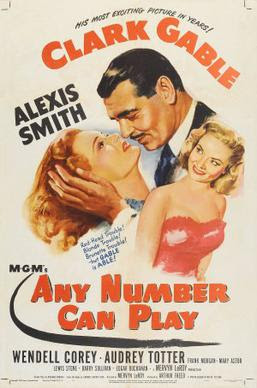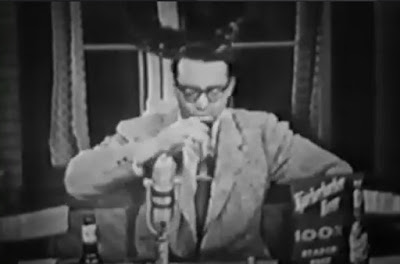Nothing particularly outstanding about that outline, I admit. But thanks to director Mervyn LeRoy, Any Number Can Play feels like a preview of the more adult dramas that would come along in the 1950s. Even the fluid cinematography and occasional long takes separates it from other studio releases of its time. Clark Gable seems to enjoy his interesting dialogue, while the women in his life -- played by Alexis Smith, Audrey Totter, Mary Astor, and Marjorie Rambeau -- are all strong and smart.
Best of all are enough familiar faces to fill a card deck. Some, like Wendell Corey as the crooked dealer, and William Conrad -- brilliant as a sleazy, sociopathic hoodlum with the annoying habit of addressing everyone as George -- were fairly new to movies in 1949. Yet the old timers stand out, too, many of them playing against type. It's the closest that they or Gable came to film noir. If you're tired of Mutiny on the Bounty or It Happened One Night, put your chips on Any Number Can Play some evening. (That's the final gambling pun you'll be reading here.)
BONUS POINTS: Imagining Louis B. Mayer having a fit in the screening room as he watched MGM's longtime loveable actors Frank Morgan and Lewis Stone playing, respectively, a nasty craps shooter, and an alcoholic, suicidal degenerate poker player.
GANGS OF NEW YORK (1938): No, this is isn't the original version of the Martin Scorsese movie. It isn't even based on the 1927 book of the same name. What it is, is one of Republic Pictures' rare non-Westerns. When gangster John Sullivan is preparing for parole from prison, he's put into a cell behind a wall in the warden's office. (Sure, every prison has one of them!). Undercover cop Rocky Thorpe, a dead ringer for Sullivan, takes his place as a gang boss, gathering evidence to pass along to authorities. But not everyone in his gang believes he's the real deal -- not even his dog or girlfriend... especially when he starts falling for Connie Benson, the sweet sister of one of the gang member's wannabes. Good thing the real John Sullivan breaks out of his one-man cell to set things straight for all involved!
Absurdities abound in Gangs of New York, which doesn't negate its entertainment value for a moment. It just might be one of the best B-movies of its genre even as you're thinking I don't believe a second of this from the first scene right through its happily-ever-after climax 67 minutes later.
Charles Bickford puts his rough manner to good use as Thorpe/Sullivan, although at times you get the feeling he realizes how nutty the script is. It's always nice to see the classy Ann Dvorak (as Connie) even as she's slumming in poverty row epics like this. Former boxer "Slapsie" Maxie Rosenbloom plays it serious for probably the first and last time of his movie career. And the should-be-better-known Harold Huber hits his usual home run as Bickford's sidekick Panatella. He's smokin' good!
BONUS POINTS: Gangs of New York was written by the eventually-legendary Sam Fuller. See, even the greats have to start somewhere.
PAGLICACCI (1936): My problem with operas is that they never stop with the
singing. And it's always in a foreign language! So props to the producers of Pagliacci, because this version from the UK is a drama with half a dozen songs from the opera sung in English!
A traveling opera troupe is performing Punchinello, in which a sad-sack clown discovers his wife cavorting with a handsome young man and her former lover. Lead actor Canio has no idea that his wife, Nedda, is doing the same thing offstage. (Pagliacci was meta before people knew what it meant). Finally discovering life imitating art, Canio exacts deadly revenge on Nedda and her bf during a performance in front of a shocked audience. Yeah! That's what we wanna see!

Pagliacci, then, is like an RKO noir with a higher pedigree. The songs roared by star Richard Tauber (a big noise in the opera world back in the day) are often difficult to understand due to his Austrian accent. But the story itself is so clear that Tauber could be singing in Mandarin and you'd know what was going on -- unlike that shmuck Canino not knowing what's going with his cheating wife. If nothing else, by watching Pagliacci you can pass yourself off as an opera buff at your next party.
BONUS POINTS: Pagliacci's prologue and climatic opera scene were filmed in the German film process Agfacolor under the name British Chemicolor. I guess the Brits were expecting Germany to become the enemy any day.
SMOOTH AS SILK (1946): Broadway actress Paula Marlowe two-times her boyfriend Mark Fenton and drunk rich kid Don Elliot in order to star in a play written by Don's uncle Stephen. (If she's two-timing two guys, does that make her a four-timer?) Mark gets his revenge by murdering Stephen and pinning it on Paula. When that ruse starts to fall apart, he convinces Don he did it while blackout drunk. But you don't think ace District Attorney John Kimble won't see through that, do you?
Even with Smooth as Silk running 64 minutes, the above synopsis sounds a little thin. That's because I've left out a few subplots that are introduced before going nowhere. Early on, it seems like Paula's kid sister Susan is going to be John Kimball's love interest, but that never happens. A guy shows up to warn Paula being accused of murder isn't going to help her career, then disappears before we find out exactly who he is. Paula herself vanishes from the movie 10 minutes before the climax, so we never find out if that mystery man's prediction is correct. At one point, it even seems like kid sis Susan is going to hook up with Don Elliot before that, too, fizzles out. Now that I think of it, you could take Susan out of the story and it wouldn't affect the story one bit.
Ahh, who cares? It's Smooth as Silk's fast pace and host of B-movie actors that make for fun viewing. Virginia Grey makes Paula Marlowe as hideous a creature as one could find -- you kind of wish she goes to the chair for a crime she didn't commit. As Mark Fenton, Kent Taylor -- a two-bit version of the similarly-named Robert Taylor -- oozes anti-charm from every pore. Familiar character actors John Litel, Charles Towbridge, and Milburn Stone round out the cast, helping to make Smooth as Silk live up to its title.
BONUS POINTS: John Litel and Kent Taylor light up their cigars at a smoke shop with a gas-powered lighter, something that today is likely quite illegal.
 THE STEVE ALLEN SHOW (12/30/53): A year before originating the Tonight show, Steve Allen hosted a similar live series local to New York, airing from 11:20 p.m. to midnight, sponsored by Ruppert Knickerbocker Beer (100% starch free, as Steve repeatedly reminds us during the live commercials where he actually drinks the stuff).
THE STEVE ALLEN SHOW (12/30/53): A year before originating the Tonight show, Steve Allen hosted a similar live series local to New York, airing from 11:20 p.m. to midnight, sponsored by Ruppert Knickerbocker Beer (100% starch free, as Steve repeatedly reminds us during the live commercials where he actually drinks the stuff).
The Steve Allen Show, then, provided the template for the original Tonight. Steve comes out, adlibs some comments, answers some audience questions, and plays a number on the piano before getting the show rolling.
Other music segments feature Steve Lawrence (singing a torch song on a set made to look like a tavern) and, later, his wife Eydie Gorme. In between, Allen interviews humorist Roger Price ("humorist" meaning he's unfunny), someone with the honorific American Campus Queen, and the astonishingly dull members of the audience. At some point, Father Knickerbocker (the sponsor's logo come to life) talks about the Brooklyn Children's Museum in excruciating detail.
Obviously, The Steve Allen Show is absolutely nothing like today's counterparts, where everyone involved appears to have been shot up with amphetamines. The whole idea of Steve's show seems to be lulling you to sleep with very gentle humor and easy-listening music. It makes more sense than Jimmy Fallon playing Charades while giggling like a maniac.
BONUS POINTS: The Steve Allen Show (and the original Tonight) originated from the Hudson Theater, where my wife and I saw Plaza Suite earlier this year. Considering tickets to the TV show were free, Steve's audience got the better deal.
***********








No comments:
Post a Comment